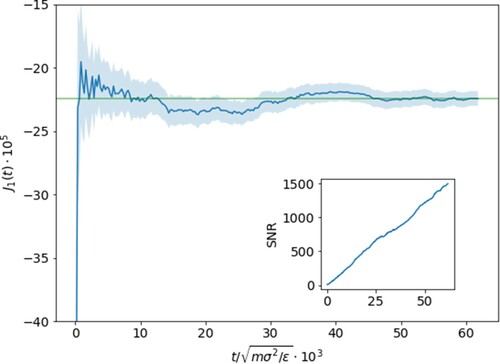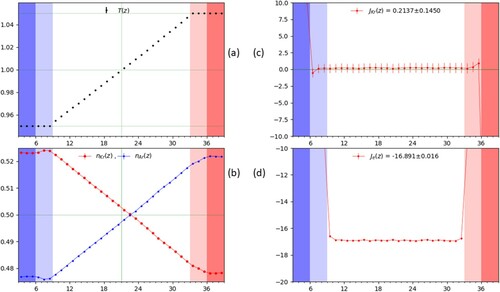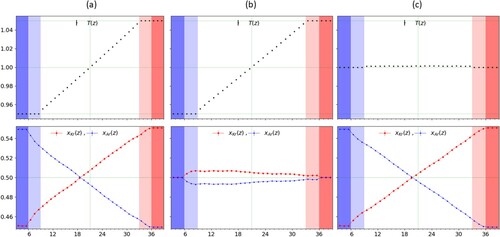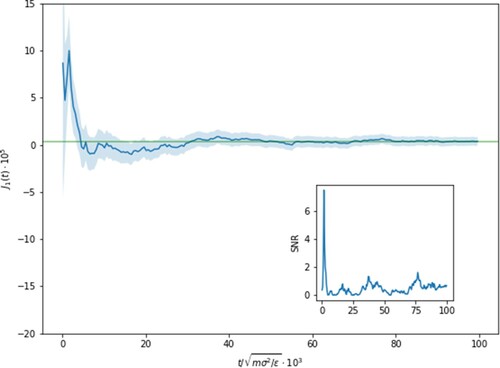Figures & data

Figure 1. (a) The subdivision of the simulation box into the different regions, the inner zone, white background, is where the fields and currents are measured, while the regions where the thermostats act on particle velocities are highlighted by different shades of blue for the lower temperature , on the left, and red for the higher temperature
, on the right, with particle exchanges taking place in the darker zones to fix the concentrations to the values
and
, respectively, as described in the text. Periodic boundary conditions are only applied in the x, y-directions, while in the z-direction the system is confined by repulsive walls, dark grey area, placed at the edges of the box. (b) A snapshot is rendered with VMD [Citation14] from the simulation data with temperature gradient
and molar fraction gradient
between the two reservoirs along the z-axis (blue arrow on-axis compass). Note a separation of Kr species (larger size, purple) particles gathering in the higher temperature region,
, as a result of the imposed concentration gradient. The empty spaces in the z-direction are the regions rarely explored by the particles where the wall potential is highly repulsive.
![Figure 1. (a) The subdivision of the simulation box into the different regions, the inner zone, white background, is where the fields and currents are measured, while the regions where the thermostats act on particle velocities are highlighted by different shades of blue for the lower temperature TC, on the left, and red for the higher temperature TH, on the right, with particle exchanges taking place in the darker zones to fix the concentrations to the values x1C and x1H, respectively, as described in the text. Periodic boundary conditions are only applied in the x, y-directions, while in the z-direction the system is confined by repulsive walls, dark grey area, placed at the edges of the box. (b) A snapshot is rendered with VMD [Citation14] from the simulation data with temperature gradient ∇T>0 and molar fraction gradient ∇x1>0 between the two reservoirs along the z-axis (blue arrow on-axis compass). Note a separation of Kr species (larger size, purple) particles gathering in the higher temperature region, TH, as a result of the imposed concentration gradient. The empty spaces in the z-direction are the regions rarely explored by the particles where the wall potential is highly repulsive.](/cms/asset/611d6d50-1546-406e-8199-a4a4aa8b6d92/tmph_a_1892849_f0001_oc.jpg)
Figure 2. Running average of the mass flux for with error shown by the shaded region. Relaxation to the stationary value occurs after
units with minor long-living fluctuations around the mean value afterwards as shown by the horizontal green line. Shown in the inset is the signal-to-noise (
) ratio which encouragingly continues to steadily climb with increasing statistics.

Figure 3. A plot of the temperature (a), mol fraction (b), mass flux of Kr (c), and energy flux (d) as a function of position along the z-direction measured in units of slice width, i.e. , with
. Each point represents the average over a slice and
are indicated by the red(right)/blue(left) shaded regions. The reservoir region in which the mol fraction is controlled consists of only the first and last 3 slices in
as described in the text and are shaded darker. The values reported in (c) and (d) are for the flux averaged across the entire bulk region, neglecting the slices in direct contact with the thermostats and where the faint green line shows the zero level. The vertical green lines in panels (a) and (b) show the equidistant point in the bulk from the reservoirs and it may be observed that the concentration profile (b) is not symmetric in shape for the two species across the bulk and indicates a preference of the heavier Kr towards the colder regions.

Figure 4. The estimated standard deviation for from the block analysis of three independent trajectory segments each of
timesteps for the (
) condition. Values for (
) are plotted against the number of timesteps in each block
, where
is the number of blocks and
. The region between 100 and 10,000 steps shows a relatively flat profile, which implies that there the block averages can be considered as independent samples. Going to shorter intervals of time, the decrease can be traced back to increasing correlations while at the other end the number of blocks
becomes too small to provide a reliable estimate of the variance of the sample.

Table 1. Check of linearity using the measured values of the temperature gradient, the energy flux, the molar fraction gradient and the mass flux for component 1, reported in LJ units.
Figure 5. The temperature (top) and concentration (bottom) profiles where panels (a), (b) and (c) are for conditions respectively. Each point represents the average over a slice and regions
are indicated by the red(right)/blue(left) shaded areas. The reservoir region in which the mol fraction is controlled consists of only the first and last 3 slices in
as described in the text and are shaded darker. From (b), one can see that while the concentration is equal at both edges, it is not enough to force the profile in the bulk to be uniform and a small gradient emerges, with opposite sign to the temperature gradient.

Table 2. Heat and mass transport coefficients from the BD-NEMD protocol.
Table 3. Comparison of the Onsager coefficients between our results (BD-NEMD) and those from the mechanical perturbation scheme by Sarman and Evans [Citation2] for a system of 1024 particles of Ar-Kr.
Table 4. Results of the measured fluxes and gradients in the bulk for the experimentally inspired protocol where .
Figure 6. Running average of the mass flux with the shaded region showcasing the error with and
to achieve mass equilibrium. Note that even after
, there is still a measurable mass flux value and that at
the uncertainty is as large as the signal. This is shown more prominently in the inset where the signal-to-noise is given over time and contrasting to the inset of Figure where the SNR rose monotonically with simulation time.

